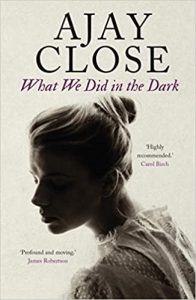 Published by Sandstone Press 13 February 2020
Published by Sandstone Press 13 February 2020
322pp, paperback, £8.99
Reviewed by Shirley Whiteside
Catherine Carswell was born in Glasgow, in 1879, and became an author, journalist and biographer. She wrote a frank, controversial biography of Robert Burns that resulted in her being rebuked from the pulpit by Burns traditionalists. She was also sent a bullet with a note asking her to ‘make the world a cleaner place’. Carswell wrote two novels, Open the Door and The Camomile. Neither were autobiographical but both drew on experiences from her own life. She always glossed over her first marriage to Herbert Jackson, an artist and soldier, whom she married within a month of meeting him. Award-winning writer Ajay Close takes the bare bones of information about this marriage and fleshes out the relationship between Catherine and Herbert in a perceptive novel that has the pace and suspense of a thriller.
The year is 1904 and 25-year-old Cathie has been studying English Literature at Glasgow University. However, although an impressive student, she cannot be awarded a degree because she is a woman. Restless and longing for excitement, Cathie meets Herbert Jackson, a Boer War veteran and artist, and agrees to marry him within a few weeks.
The Jackson family seem more relieved than happy that Herbert is marrying, and the couple takes off for an extended honeymoon in Europe. Herbert seems agitated on the journey and explains that he is being watched by persons unknown. At first Cathie is sceptical but wants to believe her new husband. Soon it becomes clear that Herbert is paranoid, and Cathie feels caught in a trap of her own making. A nightmarish journey through Italy commences, with Herbert becoming more and more unhinged. When she tells him she is pregnant, Herbert says she has been sleeping with the Prince of Wales and tries to kill her. He watches her every move and accuses her of being unfaithful with any man who comes near. Most of the story is told in the second person with Cathie addressing Herbert. This transports the reader into Cathie’s mind as she struggles to work out whether it is Herbert or herself that is losing grip, adding to the claustrophobia of the relationship.
It would be easy to portray Herbert as the villain of the piece, but the inclusion of several letters to his brother during his service in the Boer War show a different side to the man. He is wholly unsuited to army life and the atrocities that the British inflict on their Boer prisoners – many of them women and children – affect him deeply. He fails to command the respect of his men and becomes convinced that they are deliberately trying to humiliate him. His army service ends in disappointment.
Fictionalizing the lives of real people is a task full of potential pitfalls but Close’s extensive research and compassion for her characters helps her avoid them. Cathie displays hints of the courageous, modern woman she would become, one who made legal history when she decided to divorce Herbert on account of his mental health disorder and won. This is a beautifully crafted novel about a gruelling period in Carswell’s life, and it is a fitting tribute to a writer who was almost lost to obscurity.
